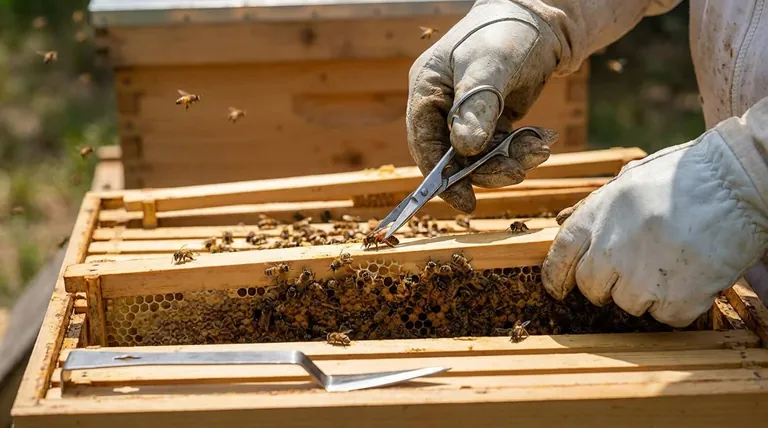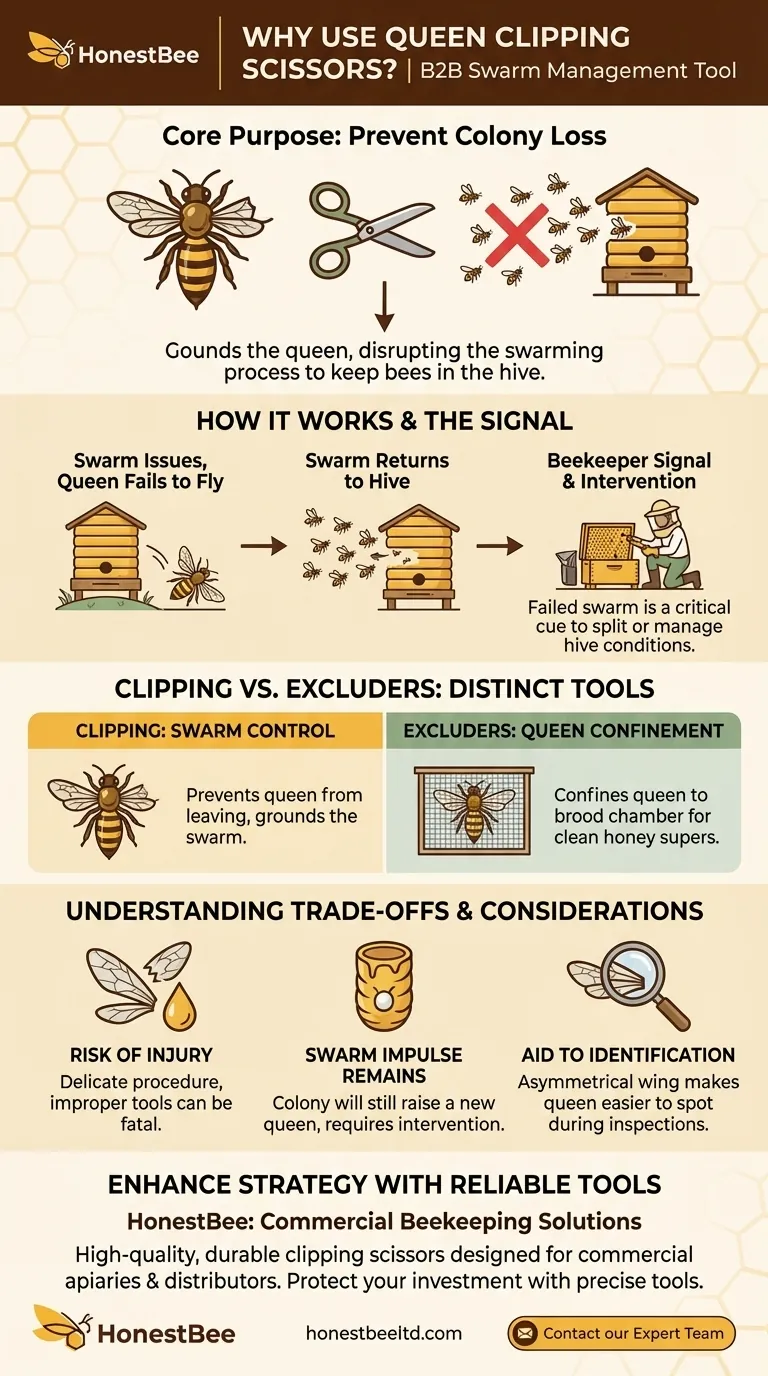At their core, queen clipping scissors are a specialized tool used to trim a small portion of one of the queen bee's wings. This simple modification renders her unable to fly, which is a deliberate management technique used by some beekeepers to prevent the colony from swarming and absconding from the hive.
The central goal of clipping a queen's wing is not to harm her, but to control the colony's behavior. By grounding the queen, you effectively disrupt the swarming process, giving you a critical advantage in preventing the loss of half your bees.

The Primary Goal: Swarm Management
A honey bee colony's natural method of reproduction is swarming. The old queen leaves with roughly half the worker bees to establish a new colony, while a new queen is raised in the original hive.
How a Clipped Wing Disrupts Swarming
When a swarm issues from the hive, the bees follow the old queen. If the queen's wing is clipped, she cannot fly.
She will attempt to leave, but will fall to the ground in front of the hive. The swarm, realizing their queen is not with them, will typically return to the original hive instead of flying away permanently.
A Critical Signal for the Beekeeper
This failed swarm attempt acts as an unmistakable signal. A beekeeper who finds the queen on the ground knows the colony has an active swarm impulse.
This gives the beekeeper a chance to intervene by splitting the hive or addressing the conditions that caused the swarming impulse in the first place, such as overcrowding.
Clipping vs. Excluders: Two Tools for Queen Control
It is crucial to distinguish between clipping and using a queen excluder. Both are methods of controlling the queen's movement, but they solve entirely different problems.
Clipping: Preventing Hive Abandonment
Wing clipping is a tool for swarm control. Its purpose is to prevent the queen, and by extension the swarm, from successfully leaving the hive and being lost forever.
Excluders: Confining the Queen's Location
A queen excluder is a screen with gaps large enough for worker bees but too small for the larger queen. Its purpose is to confine the queen to the lower brood chamber.
This prevents her from laying eggs in the upper boxes (honey supers). Keeping brood out of the honey supers is essential for clean and efficient honey harvesting.
Understanding the Trade-offs
Clipping is an effective technique, but it is not without debate or risk. It's a choice that depends on the beekeeper's philosophy and skill.
The Risk of Injury
Clipping the queen's wing is a delicate procedure. Using improper tools or an unsteady hand can result in cutting her leg or abdomen, which can be fatal. Specialized, blunt-tipped scissors are designed to minimize this risk.
Does It Stop the Swarm Impulse?
Clipping does not stop the bees from wanting to swarm. The colony will still raise a new queen cell.
If the beekeeper doesn't intervene, that new virgin queen will hatch, and she will be able to fly. She may then leave with a swarm, defeating the original purpose of clipping the old queen.
An Aid to Identification
A minor but helpful benefit of a clipped wing is that it makes the queen easier to spot during hive inspections. The asymmetrical wing pattern stands out among the thousands of other bees.
Making the Right Choice for Your Goal
Ultimately, these techniques are tools to achieve specific management objectives. Your choice should align directly with the problem you are trying to solve.
- If your primary focus is preventing the loss of bees to swarming: Clipping the queen's wing is a direct, though not foolproof, method to keep the colony from absconding.
- If your primary focus is simplifying honey harvesting: A queen excluder is the essential tool for ensuring your honey supers remain free of eggs and larvae.
- If you are managing multiple techniques: You might use both; clipping to manage swarming and an excluder to manage honey production in the same hive.
Understanding the distinct purpose of each tool is the first step toward effective and responsible hive management.
Summary Table:
| Tool | Primary Purpose | Key Benefit | Key Consideration |
|---|---|---|---|
| Queen Clipping Scissors | Swarm Control | Prevents colony loss by grounding the queen | Requires skill to avoid injuring the queen; does not eliminate swarm impulse |
| Queen Excluder | Honey Harvesting | Confines queen to brood chamber for clean honey supers | Solves a different problem (queen location) than swarming |
Ready to enhance your swarm management strategy with reliable tools?
As a commercial beekeeper or equipment distributor, preventing colony loss is critical to your operation's productivity and profitability. HONESTBEE supplies high-quality, durable beekeeping supplies and equipment—including specialized queen clipping scissors—designed specifically for the demands of commercial apiaries and wholesale distributors.
We help you protect your investment by providing the precise tools you need for effective hive management. Contact our expert team today to discuss your specific needs and explore our wholesale-focused product catalog. Let's work together to build a more resilient and successful beekeeping operation.
Visual Guide

Related Products
- HONESTBEE Professional Long Handled Hive Tool with Precision Cutting Blade
- Heavy Duty Stainless Steel Queen Bee Catcher Clip
- HONESTBEE Advanced Ergonomic Stainless Steel Hive Tool for Beekeeping
- Professional Dual-End Stainless Steel Hive Tool for Beekeeping
- Honeycomb Uncapping Knife for Apiculture
People Also Ask
- What is the hive tool used for? The Essential Multi-Tool for Every Beekeeper
- What is a hive tool used for in beekeeping? Your Essential Guide to Hive Management
- What are some common uses of a hive tool? Essential Multi-Purpose Tool for Every Beekeeper
- Why do hive tools have a hole? Unlock the Secret to Efficient Beekeeping
- What are the features of a regular hive tool? The Essential Multi-Tool for Every Beekeeper



















